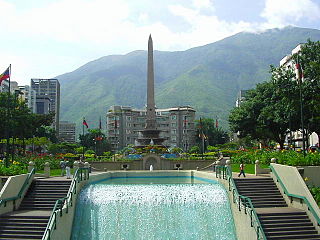Plaza France (Caracas)
The Plaza Francia (or Plaza Altamira, as it is alternatively called) is a square located in the Altamira urbanization to the east of the city of Caracas. Administratively, it is part of the Chacao parish in the Chacao Municipality of Miranda State, in north-central Venezuela.
History
It was designed by Arthur Kahn, the architect of the Altamira building in Plaza Francia who arrived in Venezuela in July 1942, a Venezuelan by nationality, with almost 70 years of residence in the country. He was born in Istanbul, Turkey, on October 10, 1910. It was built by the urban planner Luis Roche, one of the largest builders of the time, within the Altamira urbanization project, a wealthy sector of the Chacao municipality of Miranda state.
It was built in the early 1940s and inaugurated on August 11, 1945 under the name of "Plaza Altamira". Later its name changed to Plaza Francia after an agreement between the cities of Caracas and Paris to have a Plaza Francia in Caracas and a Plaza Venezuela in Paris.
In the Plaza, the Obelisk of Altamira, symbol of the Chacao Municipality, the Espejo de Agua and a fountain that falls towards the end of the plaza that has become a small shopping center and the main exit of the Caracas Metro stand out. at the Altamira Station.
Before 1940, the Altamira area was a 110-hectare farm called El Paraíso, with the large crystalline ravines Pajaritos, Quebrada Seca and Quintero or Chacao ravine, tributaries of the Guaire River, which descended from north to south from the mountain that borders the city of Caracas to the north called Cerro el Ávila.
Plaza Altamira was conceived as a center of attraction for this new development. Large avenues pass along three of its sides (South: Av. Fco. de Miranda / East: Av. Luis Roche / West: Av. San Juan Bosco).
It should be noted that its obelisk was at the time the tallest construction in the city.
Oil strike
In mid-August 2002, a group of active and retired military officers who had been involved in the April coup spoke out against the government in Plaza Altamira in an unarmed uprising. more soldiers joined the protest until they reached about 120 officers. It was widely supported by thousands of supporters, by opposition politicians and even by celebrities, who kept the square full at all hours.
Plaza Francia had become the main meeting point for the opposition and thousands of people gathered there every day to listen to the more than one hundred active soldiers who had spoken out against the government and gave speeches there. square, together with prominent leaders of opposition parties, artists, businessmen and personalities who appeared there every day to motivate the protesters. Television teams from private channels broadcast live reviewing everything that happened.
On the night of December 6, at approximately nine o'clock at night, a large group of people were present in the square when, suddenly, a group of an unknown number of gunmen and snipers, presumably three, fired more than twenty shots against the group of protesters. The shooter, an individual named João de Gouveia, was immediately captured thanks to a joint action between protesters and police. The opposition protests intensified due to the incidents in the square. They entered causing chaos and confusion, they shot at the concentration, killing three people and injuring about 25 people.
2017 protests
Plaza Altamira was a meeting point and epicenter of protests in the demonstrations that began in April after the Supreme Court of Justice issued sentences against the National Assembly. Part of the student population took to the streets protesting what happened.
Gallery
See also
- Plaza Italia
- Plaza Venezuela (Paris)






